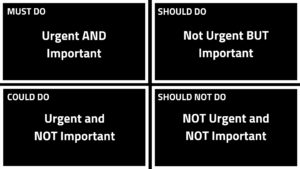The headline of a 2017 article of Forbes magazine referenced a study that stated time as “the most valuable commodity.” Unlike money, where there are unlimited opportunities to make more, time is a non-renewable commodity. Once time is used, it’s gone.
One of my favorite quotes about time is by AW Tozer. He said, “Time is a resource that is nonrenewable and nontransferable. You cannot store it up, slow it up, hold it up, divide it up or give it up. You can’t hoard it up or save it for a rainy day – when it’s lost it’s unrecoverable. When you kill time, remember that it has no resurrection.”
It will not surprise you, we each get the same amount of time, twenty-four hours in a day, one hundred and sixty-eight hours a week. There’s not a select group of people or location on the planet that gets more or less. It doesn’t matter how rich or poor, educated or uneducated…we all have the same amount……no more no less.
That’s why author Kevin Kruse, in his book 15 Secrets Successful People Know About Time Management: The Productivity Habits of 7 Billionaires, 13 Olympic Athletes, 29 Straight-A Students, and 239 Entrepreneurs says, “Time is unique because it’s the one true equalizer.”
The big differentiator between the “time wealthy” and the “time poor” is not the amount of time but what’s done with the time one has.
When I was a kid, every time I earned a couple of dollars, I would want to go to the store and spend it as quickly as possible. My dad would always say, the money was “burning a hole in my pocket.” I was not a good manager of money. The same could be said of many people. They blow through time, not realizing the value of it.
The truth is time cannot be managed. However, you can control what you do with the time you have. Here are three practices that, if done regularly, will keep time from “burning a hole in your pocket.”
PRIORITIZE YOUR TIME
Jason Selk in the book Organize Tomorrow Today writes, “The most successful people don’t get everything done. They get the most important things done.” But how do you determine the most important things?
Here is a framework that I have found helpful to dial in priorities.
MUST DO, SHOULD DO, COULD DO, SHOULD NOT DO
I base this framework on the Eisenhower matrix, made famous by author Stephen Covey in the Seven Habits of Highly Successful People. On a sheet of paper create a box with four quadrants. Label the top left MUST DO. Namethe bottom left, COULD DO. The top right quadrant, label SHOULD DO. Finally, name the bottom right quadrant SHOULD NOT DO.
Now, make a list of all the things you are responsible for and the way you use your time include projects you are working on, regular tasks and assignments, activities that you do on a regular basis, and goals that you want to accomplish. All items that are urgent AND important write down in the MUST DO quadrant. These activities should take first priority. They are activities that need to be dealt with immediately. The goal would be to reduce the number of items that land in this quadrant. You can cut these through prevention and preparation.
Now do move to the COULD DO quadrant. Place activities that are both urgent and NOT important. The items in this quadrant are often the result of someone else’s sense of urgency based on their priorities. Living out of this quadrant, you may feel rushed to get things done as well as a lack of satisfaction when they’re completed. Many times the tasks in this quadrant are distractions!
In the SHOULD DO quadrant write down all the things that are not urgent BUT important. The activities in this quadrant need to be your focus. These are the activities you should begin to prioritize. Too often this quadrant is pushed aside to the tyranny of the urgent. However, you can only push aside the things that matter most like relationships, health, and learning before time runs out.
Finally, put all the things are NOT urgent and NOT important in the SHOULD NOT DO quadrant. Activities in this quadrant are merely time wasters. Strive to minimize the amount of time you spend on activities falling in this quadrant.

There will be times when your priorities compete with one another; times when there simply is not enough time to accomplish the things you must do and the things you should do This is where the lens of “significance” can be helpful.
Significance takes into account the impact of the priority. To use a business concept, which priority will produce the highest ROI (Return on Investment)? One priority may have an immediate impact and seem like the thing to do. However, another activity could have a longer lasting impact and needs to take precedence.
Here’s the benefit of prioritizing your time. When you know your priorities, it gives clarity on what you say YES to and to what you say NO.
The most powerful word in your vocabulary is NO! Every time you say YES to something, you are saying NO to something else.
“YES lives in the land of NO!”
PROTECT YOUR TIME
Protecting your time is such an important practice. If you don’t protect your time, it is vulnerable to be stolen by something or someone else. You have to control what goes on your calendar and in your schedule. An excellent process for this is time (calendar) blocking.
Time blocking is a productivity practice for scheduling your time around your priorities. It does what it says; it blocks other people’s agendas that are not your priorities from getting on your calendar. Time blocking encourages discipline around your priorities. By creating a proactive schedule, you can pace your progress toward your deadlines. Time blocking gives guardrails for saying “No.”
Numerous blog posts teach the specifics of time blocking. However, let me give you a quick overview of how you can begin time-blocking your calendar.
Start with a blank calendar app or paper calendar. One of the features of most app-based calendars is the ability to mark BUSY and OUT OF OFFICE for each of your blocks, an easy “NO” without the need to say no.
Now, begin by putting your priorities (commonly referred to as “Big Rocks”) on your calendar. Include your standing appointments, items from your “should do” quadrant, family vacations or personal trips, etc. Block out the time or the day(s) needed for each.
“Spending your time on paper before the week begins makes all the difference in how your weekends!” — Teresa McCloy
Next, fill in the blanks. These are your “must do’s” and “could do’s.” Teresa McCloy, A friend of mine, teaches four P’S for Time Blocking; project, process (preparation), people, and presence (Mindfulness) blocks. I like to add a fifth “p,” play blocks (you can’t be productive 24/7).
You can personalize your time blocking system in ways that work for you. I like to use color coding, labeling and adding travel time to activities or events.
Here is a statement you should remember and take to heart. If it doesn’t make it on your calendar, it probably won’t make it in your life.
MAXIMIZE YOUR TIME
The third way to move from time poor to time wealthy is to practice mastering your time, which is about thinking in smaller units of time. One of the characteristics of highly productive and successful people is that they focus on minutes where most people focus on hours.
There is a principle called “Parkinson’s Law” that says work expands to fill the time available for its completion definition. If yourself 3 hours to accomplish a task, it will take you the entire 3 hours to complete. However, if you give yourself 30 minutes to finish the same project, you will get it done in 30 minutes.
Here are two things you can start doing immediately to maximize your time.
COMPRESS TO PROGRESS
Our default is to think in a half-hour or hour chunks of time. What would happen if you began to reduce your default thinking to smaller segments of time? Imagine what you could accomplish. An easy way to start compressing time is by changing the defaults. Instead of scheduling a meeting for one hour, compress it to 45 minutes. In the same way, shorten a 30minute meeting to 20 minutes. Put Parkinson’s Law into practice with any project, assignment or task.
BE PREPARED
There are always unexpected, unscheduled chunks of time that pop up during the day. What do you do with that time? A lot of people take the opportunity to exhale, spend a few minutes chatting with co-workers, surf the web, or check out their Facebook, LinkedIn or Instagram feed.
Don’t be like other people. Be prepared to maximize those soft spots in your schedule with something productive. Determine the minimum amount of time needed to accomplish something on your task list. It could be as few as 2 minutes. If a meeting ends early and you have 15-minutes of freed up time, or something gets canceled last minute on your calendar go to your list of tasks find the most important things you can knock out in that freed up window and just like that, you have won back time by being prepared.
My favorite tool for being prepared is Nozbe. Where ever I am, I have my current task and project list with me on my phone. I can see what priorities I need to accomplish, the amount of time I have projected each task to take, and the resources I need to complete them. So, if I find myself with unexpected time, I can see the tasks that I can accomplish in the amount of time I have, in the place I am, with the resources (phone, computer, etc.) I have.
I once heard it said that if you master your minutes, you can master your life. Kevin Kruse reminds us that each of us only gets 1440 minutes each day. By applying the three strategies of prioritizing, protecting and maximizing your time you can avoid losing time and use the time given to you effectively.
[et_bloom_inline optin_id=”optin_3″]

